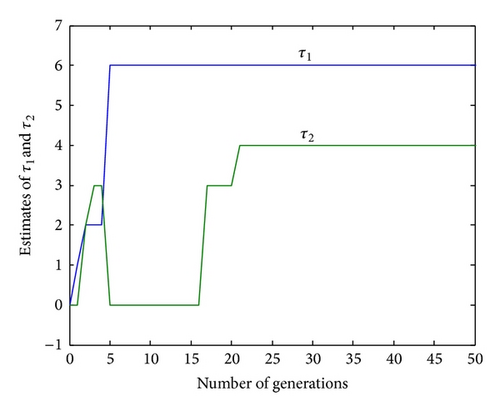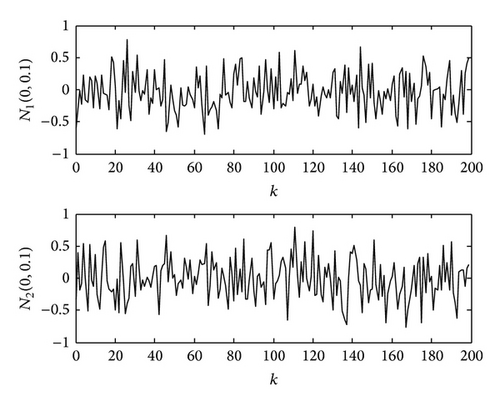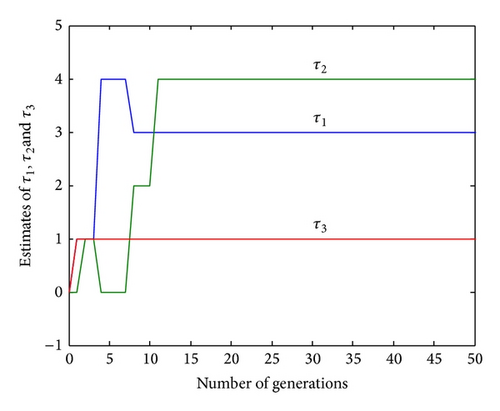Multiple Input Delays Estimation Using an Artificial Bee Colony Algorithm
Abstract
This paper focuses on the time delay estimation of the system described in the form of discrete-time state equation with multiple input delays. To estimate the input delays, a new evolutionary computation called the artificial bee colony (ABC) algorithm is utilized. This algorithm is originally motivated from the social behaviors of honeybee organization, and it has been proven to be a powerful means for solving the optimized problem. Based on the proposed algorithm, the unknown system input delays can be further solved by minimizing a quadratic cost function of the system. Two illustrative examples are provided to verify the potential of the presented method in the time delay estimation. Some simulations containing different initial condition examinations and appearance of noises are further given. Numerical results show that the proposed method can do well in the multiple inputs delay estimation of discrete-time state equations.
1. Introduction
Among numerous evolutionary computations developed in recent years, artificial bee colony (ABC) algorithm has attracted many researchers’ considerable attentions and also been applied in a variety of engineering optimization problems. It was initially developed by Karaboga and spread out by his research teams [1–4], and it is a population-based optimization algorithm like other evolutionary computations. Thus, this algorithm is in parallel to seek for the global or near global solution of the optimized problem, not a single direction search such as the gradient descent method. The ABC algorithm is motivated from the physical bee swarm behavior and possesses a powerful searching capacity on optimizations. In the real honeybee colony, there are three different types of foragers which are the employed bees, onlookers, and scouts [1]. The employed bee is a bee that is going to the food source visited by itself previously, the onlooker is a bee that is waiting on the dance area for making decision to select some food source, and the scout bee means that a bee is carrying out random search for food sources. Furthermore, each employed bee goes to one food source, and, therefore, this implies that the number of employed bees is identical with the number of food sources. An employed bee will become a scout when her food source is exhausted by herself and onlooker bees.
In [1], Karaboga and Basturk have shown that the proposed algorithm is superior to some evolutionary algorithms, for example, genetic algorithm, particle swarm optimization, particle swarm inspired evolutionary algorithm, and so on. A large number of engineering applications combined with the ABC algorithm have been developed in recent years [5–11]. In [5], a nonlinear chemical CSTR process system was controlled by using proportional-integral-derivative (PID) controller from the stable equilibrium point to unstable equilibrium point. The design method for tuning PID control gains is the ABC algorithm. In [7], the authors proposed an optimal design method for the reactive power flow in which the active power loss was minimized by the ABC approach. In machining operations, selection of cutting parameters is an essential task for reducing the cost of products. Yildiz developed an optimization approach by using artificial bee colony algorithm for optimal selection of cutting parameters in multipass turning operations. Simulation results revealed that the ABC algorithm outperforms other optimization techniques [8]. Besides, Huang and Liu presented the ABC algorithm to enhance the fault section estimation performance in power systems [9]. The proposed method can reduce the possibility of inaccurate diagnosis and find the accurate fault section among voluminous alarms.
Another issue considered in this paper is concerned with the time delay estimation. Time delay problem often occurs in many physical situations such as sensor array, sonar, medical imaging, and communications because of the inherent system dynamics and instrumentations. Especially for the control engineering and system identification, the time delay information is of importance. It is attractive and practical to directly estimate these delays according to the measured data rather than making an attempt to obtain them from a physical understanding of systems [12]. To cope with time delay estimation, many techniques were developed in the literature [12–17]. In [14], the authors proposed a novel time delay estimation approach by sliding discrete Fourier transform, and the maximum magnitude of the spectrum and its corresponding phase offset were utilized. It was shown that the proposed method outperforms the standard correlation-based method. Shaltaf then developed a Neurofuzzy-based approach combined with discrete cosine transform (DCT) coefficients for time delay estimation problem [15]. However, a design method for system time delay estimations based on using ABC optimization algorithm seems not to be reported to date. Thus, this paper will focus on the issue of multiple time delays estimation and develop an ABC-based approach to solve such a delay estimation problem. It is requested to define a quadratic cost function of the system at the beginning; the developed ABC algorithm then minimizes this function by means of certain mechanisms, and the actual time delays can be estimated correctly. Besides, the effect of initial condition of the algorithm on the estimation performance is also considered. The rest of this paper is organized as follows. In Section 2, the system formulation for multiple input time delays of discrete-time state equations is addressed. The concept and evolutionary computation of the ABC algorithm is firstly introduced in Section 3, and the design steps combined with ABC for such a time delay estimation is proposed. In Section 4, two illustrative examples are given to confirm the potential of the developed method, and some examinations including different independent runs and appearance of noises are further performed. Finally, Section 5 gives some simple conclusions.
2. System Formulations
3. ABC Algorithm and Its Application to Time Delay Estimation
In recent years, Karaboga and his teams have developed a large number of literatures regarding the ABC algorithm and its application to diverse engineering fields such as cluster [3], parameter optimization [18], and symbolic regression [19]. They already showed that the ABC algorithm is an efficient means for solving the optimization problems and is superior to other evolutionary computations like GA, PSO, and DE algorithms. The foragers of honeybee society consist of the following behavior models [1, 5]. Firstly, a set of food source positions are chosen at random by bees, and the nectar amount related to each food source is calculated. These honeybees then come back to the hive to share the nectar information of sources with other bees that are waiting on the dance area. Secondly, each of employed bees, after sharing the information, still goes to the neighborhood of the original food source which was visited by herself previously and then selects a new food source by visual information. Thirdly, the onlooker prefers a food source area depending on the nectar information shared by employed bees on the dance area. While the nectar amount of a food source increases, the probability of choosing such a food source by an onlooker increases as well. The onlooker bee then flies to arrive at the selected area and seeks for a new food source around this area. Visual information is based on the comparison of food source positions. Lastly, a scout bee will randomly find out a new food source to take the place of the previous one when its nectar is abandoned by the honeybee. The artificial bee colony is developed by mimicking such model of foraging bees.
Following the above descriptions, some central components of the ABC algorithm need to be explained in detail [1, 5].
3.1. Food Source
In the ABC algorithm, the notation for the ith food source is denoted by Θi. Each of food sources represents a possible candidate solution to the optimized problem, and note that the number of food sources is the same with that of employed bees. As can be seen from (4), for time delay estimation problem, the ith food source can be further expressed by Θi = [θi1, θi2, …, θip] consisting of p elements.
3.2. Population Size
A population is composed of numerous food sources, and here it is assumed that the size of population is H. Thus, for each food source position, it can be denoted by θij for i = 1, 2, …, H and j = 1, 2, …, p.
3.3. Probability Related to Food Source
3.4. New Food Source Position
3.5. Abandoned Food Source
In the real-world situation, the food source may be further replaced by a new food source when its nectar has been abandoned by honeybees. In the ABC algorithm, therefore, if the cost function derived from some food source cannot be improved through an assigned number of generations (here called limit), such a food source is abandoned. After that, a new food source instead of the abandoned one will be produced from the original interval.
3.6. Termination Condition
This algorithm stops if the number of generations achieves the maximum allowable number G which is assigned by the designer.
Designing steps for solving the time delay estimation problem based on ABC algorithm can be summarized in the following.
Data. A discrete-time state equation with some unknown input delays described by (1), a mathematical model of (2) for modeling (1), control input ui(k) ∈ R for i = 1,2, …, p, the sampling number N, population size H, parameter limit, and number of generations G.
Goal. Accurately estimate the real input delays τ1, τ2, …, τp of (1) by using the proposed ABC algorithm to minimize the cost function defined in (3).
Step 1. In the beginning, a population consisting of H food sources is randomly established from the interval [0, 1].
Step 2. If an assigned number of generations G is achieved, then the algorithm stops.
Step 3. Calculate the cost function J(Θi) of every food source Θi by using (3).
Step 4. Evaluate every probability Pr(Θi) of Θi by using (5).
Step 5. Generate a random number from [0, 1], and if the probability Pr(Θi) is less than this generated number, then a new food source is derived by means of (6).
Step 6. Further calculate , and let this new food source replace the original Θi if <J(Θi); otherwise, the present food source Θi still remains, and the new one is discarded.
Step 7. When the number of generations is equal to the number, limit, check every Θi whether its positions have been modified or not. If not yet, this food source is removed, and correspondingly a new food source is generated from the initial interval [0, 1].
Step 8. Go back to Step 2.
4. Illustrative Examples
This section will show the applicability of the ABC-based approach to the time delay estimation by using two illustrative examples. For all the following simulations, the related parameter setting for the ABC algorithm is given by the population size H = 40, limit = 20, number of generations G = 100, and sampling number N = 200 in (3).
Example 1. Let us consider the first example which is a discrete-time state equation with three state variables and two system inputs described by [16]
| Run 1 | 6 | 4 |
| Run 2 | 6 | 4 |
| Run 3 | 6 | 4 |
| Run 4 | 6 | 4 |
| Run 5 | 6 | 4 |
| Run 6 | 6 | 4 |
| Run 7 | 6 | 4 |
| Run 8 | 6 | 4 |
| Run 9 | 6 | 4 |
| Run 10 | 6 | 4 |

Example 2. In the second example, a discrete-time state equation with two state variables and three system inputs is considered and can be expressed by
| Run 1 | 3 | 4 | 1 |
| Run 2 | 3 | 4 | 1 |
| Run 3 | 3 | 4 | 1 |
| Run 4 | 3 | 4 | 1 |
| Run 5 | 3 | 4 | 1 |
| Run 6 | 3 | 4 | 1 |
| Run 7 | 3 | 4 | 1 |
| Run 8 | 3 | 4 | 1 |
| Run 9 | 3 | 4 | 1 |
| Run 10 | 3 | 4 | 1 |


5. Conclusions
This paper has successfully developed an estimation approach for the discrete-time state equation with multiple input time delays. The estimation method is based on the artificial bee colony algorithm which is one of new evolutionary computations. By mimicking the social behaviors of honeybees, such an algorithm can be used to solve the system optimization problem. In this paper, the detailed descriptions for ABC algorithm have been presented, and the design steps combined with the proposed ABC algorithm have also been given for multiple input time delay estimations. It is concluded form two illustrative examples that the ABC-based approach has a satisfactory outcome for solving the time delay estimation problem.




